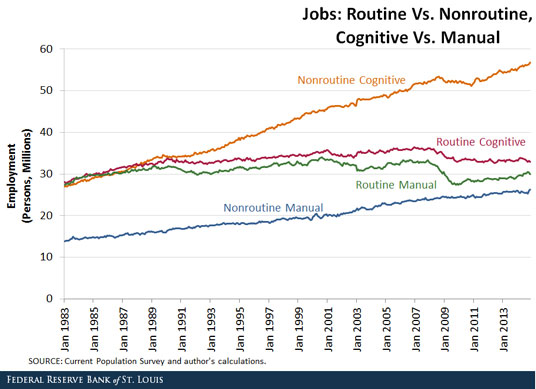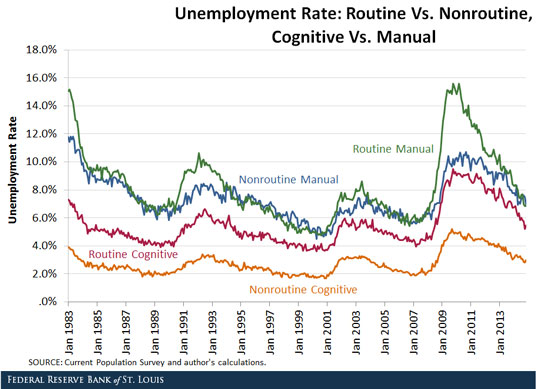Jobs Involving Routine Tasks Aren't Growing
U.S. labor markets are undergoing important long-run changes. These include:
- The decline of middle-skill occupations, such as manufacturing and production occupations
- The growth in both high- and low-skill occupations, such as managers and professional occupations on one end, and assisting or caring for others on the other.
Economists have coined the term “job polarization” for this process.1 As has been argued in the economic literature, the most likely drivers of job polarization are automation and offshoring, as both these forces lower the demand for middle-skill occupations relative to the rest.
For example, some jobs that require performing routine or repetitive tasks can be automated. Also, some stages of the production process of a good or service can be performed in foreign countries. Therefore, some tasks can be outsourced. In general, the types of tasks that can be outsourced are mostly routine tasks.
Total Employment
Given this, it is important to classify occupations according to how routine their tasks are. It is also important to classify occupations by whether they use mostly cognitive skills or mostly manual skills (brain vs brawn). The following figure shows the evolution of U.S. employment across four types of occupations:
- Nonroutine cognitive occupations, which include management and professional occupations
- Nonroutine manual occupations, which include service occupations related to assisting or caring for others
- Routine cognitive, which include sales and office occupations
- Routine manual, which include construction, transportation, production and repair occupations2

The picture is clear: Employment in nonroutine occupations—both cognitive and manual—has been increasing steadily for several decades. Employment in routine occupations, however, has been mostly stagnant.
Another pattern emerging from the graph is the more pronounced volatility of routine occupation employment over the business cycle. This is the result, in large part, of the cyclicality of industries in which these occupations are largely employed.3
Unemployment Rate
A look at the unemployment rate provides complementary information. The following figure presents the evolution of the unemployment rate for the four occupational groups previously described.4

Occupations requiring a higher degree of cognitive skills had, on average, a lower unemployment rate. Also, routine manual jobs had a larger volatility in the unemployment rate, and nonroutine cognitive jobs had a smaller volatility. Nonroutine manual and routine cognitive jobs, on the other hand, had similar volatilities in the unemployment rate and, towards the end of the sample, similar levels.
Since the processes of automation and offshoring will most likely continue, it is expected that the disappearance of routine jobs in the U.S. will also continue. Understanding the impact of polarization on the labor market is important and remains an active topic of economic research.
Notes and References
1 For example, see Goos, Maarten; and Manning, Alan. "Lousy and Lovely Jobs: The Rising Polarization of Work in Britain." The Review of Economics and Statistics, 2007, Vol. 89, No. 1, pp. 118-33; Autor, David H.; Katz, Lawrence F.; and Kearney, Melissa S. “The Polarization of the U.S. Labor Market.” The American Economic Review, Papers and Proceedings 96, 2006, No. 2, pp. 189-94; and Autor, David H.; and Dorn, David. "The Growth of Low-Skill Service Jobs and the Polarization of the U.S. Labor Market." The American Economic Review, 2013, Vol. 103, No. 5, pp. 1553-97.
2 I excluded farming, fishing and forestry occupations and military occupations.
3 This has been carefully analyzed in Foote, Christopher L.; and Ryan, Richard W. “Labor Market Polarization over the Business Cycle.” NBER Macroeconomics Annual 2014, 2015, Vol. 29, pp. 371-413.
4 The unemployment rate of an occupational group is defined as the total number of workers whose last occupation was in that group, divided by the sum of those same unemployed workers and the employed workers in that occupational group.
Additional Resources
- Working Paper: Trade and Labor Market Dynamics
- On the Economy: It’s the Older Workers Who Have the Job Skills
- On the Economy: Long-Term Unemployment Hit Which Ages Hardest?
Citation
Maximiliano A. Dvorkin, ldquoJobs Involving Routine Tasks Aren't Growing,rdquo St. Louis Fed On the Economy, Jan. 4, 2016.
This blog offers commentary, analysis and data from our economists and experts. Views expressed are not necessarily those of the St. Louis Fed or Federal Reserve System.
Email Us
All other blog-related questions


